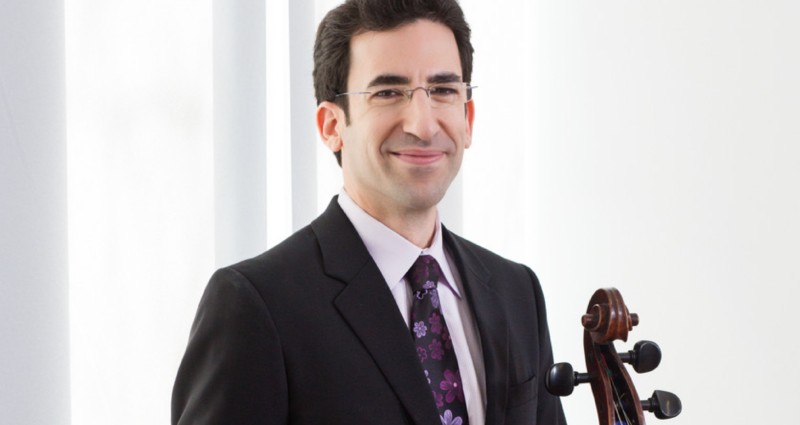- This event has passed.
SEBASTIAN CURRIER (b. 1959)
Spark
Camden Archambeau, Edward Arron, Denise Djokic, Ahrim Kim, Keiko Ying, Daniel McDonough, Amir Eldan, Leo Kubota, David Ying, Isaac Pagano-Toub, Kyle Victor, Isaac Berglind, cello
LUDWIG VAN BEETHOVEN (1770–1827)
Sonata for Piano and Cello No. 2 in G Minor, Op. 5, No. 2
-
- Adagio sostenuto ed espressivo — Allegro molto più tosto presto
- Rondo. Allegro
Edward Arron, cello • Tao Lin, piano
JOHANNES BRAHMS (1833–1897)
Piano Quintet in F Minor, Op. 34
-
- Allegro non troppo
- Andante, un poco adagio
- Scherzo. Allegro
- Finale. Poco sostenuto – Allegro non troppo – Presto, non troppo
Renée Jolles, Meg Freivogel, violin • Che-Yen Chen, viola • Amir Eldan, cello • Jon Nakamatsu, piano
PROGRAM NOTES
SEBASTIAN CURRIER
Spark (2014)
When one thinks of the cello, possibly the first attribute that comes to mind is its lyrical and sensual expressiveness. But it also has another side: an earthy intensity that can be transformed into a rough, charged, and almost manic virtuosity. It is this latter affect that I sought in Spark. With a ceaseless stream of repeated notes and figurations, Spark continually charges forward, the low, earthy tone of the cellos only occasionally interrupted by brief, effervescent flashes of harmonics, which fly by like sparks. The work is written for the 12 celli of the Berlin Philharmonic.
Program Note by Sebastian Currier
LUDWIG VAN BEETHOVEN
Sonata for Piano and Cello No. 2 in G Minor, Op. 5, No. 2 (1796)
Beethoven’s two Sonatas for Piano and Cello, Op. 5, are often heralded as works of unprecedented innovation which gave rise to the “cello sonata” as we know it today. On the face of it, this is true. Prior “sonatas” for cello and keyboard had emerged along two traditions: in the early eighteenth century, composers like Vivaldi had written sonatas for cello solo with “continuo” — meaning an unwritten part for a keyboard, who would be expected to improvise harmony based on numerical, “figured bass” indications. Conversely, by the turn of the nineteenth century, it was most common for composers to write veritable sonatas for keyboard with cello “accompaniment,” where the cellist (if one was available) would reinforce the keyboardist’s bassline. With his Op. 5, Beethoven wrote the first cello sonatas in which both instrumentalists’ parts are independent and fully scored.
Even so, is it right to view these works as exemplifying Beethoven’s spirit of innovation? Perhaps; but the more direct stimulus for these sonatas was their dedicatee (and Beethoven’s prospective patron), Friedrich Wilhelm II, King of Prussia. Knowing the king to be an enthusiastic and skilled cellist (for whom Mozart had not long before composed his “Prussian” string quartets), Beethoven strategically composed two sonatas, allowing him to display his own keyboard prowess while also showcasing the talents of the brothers Duport, the cellists who taught the king. The virtuosity of both instrumentalists reaches a fever pitch at the end of the Rondo, with brilliant passage work in the piano part coupled with swift octaves in the cello. If Mozart felt that Friedrich Wilhelm had been rather stingy with his quartet commissions, Beethoven could not make the same complaint. Following his and Duport’s performance of the Op. 5 sonatas at Potsdam, the king reportedly rewarded Beethoven with one hundred Louis d’or in a golden snuffbox.
JOHANNES BRAHMS
Piano Quintet in F Minor, Op. 34 (1865)
Brahms’ Piano Quintet belongs to an outpouring of chamber music from the early 1860s — the period musicologists generally call Brahms’ “first maturity” — which also gave rise to his two string sextets, his first two piano quartets, and the horn trio. The style Brahms cultivated during these years is partly accountable to his historicist sensibility: his appreciation for the large-scale formal arcs and emotional intensity of Beethoven, to be sure, but also his study of the unhurried melodies and harmonic sorcery of Schubert, whose instrumental music was considerably less known at that time.
But the final form of the Piano Quintet is also the result of Brahms’ dialogue with a trusted coterie of performers who offered critical feedback. The musical substance began its life scored for string quintet, with two cellos (suggesting that Brahms was keeping the score of Schubert’s glorious cello quintet nearby). He presented this version of the work to violinist Joseph Joachim, a close friend and tireless advocate of Brahms’ work. After rehearsing the work with colleagues, Joachim disclosed his misgivings to Brahms: “every line shows proof of an almost overwhelming creative strength, full of spirit through and through.” But, Joachim continued, “the instrumentation is not energetic enough to my ears to convey the powerful rhythmic convulsions; the sound is almost helplessly thin for the musical thought. Then again for long stretches everything lies too thickly. You surely can’t like it either: it sounds artificial!” After some unsatisfactory attempts to salvage the work as a string quintet, Brahms (always the perfectionist) burned the score, and decided to rearrange the work as a Sonata for Two Pianos. It was in this form that Op. 34 received its premiere in 1864, Brahms playing with Karl Tausig, a student of Liszt. But when Brahms shared this version with Clara Schumann, his confidante betrayed her own doubts: “The first time I played it I had the impression it was an arrangement. It cannot be called a sonata; rather, it is a work whose ideas you could — and should — distribute among the whole orchestra, as though out of a horn of plenty!” Perhaps it is fitting, then, that Brahms ultimately found the perfect compromise in the Piano Quintet formation — something of a hybrid, preserving the best elements of both previous ventures — a genre which had been pioneered by Robert Schumann two decades prior. Unlike the string quintet, however, Brahms did not destroy the two-piano version, which continues to enjoy occasional performance to this day.
Program Notes by Peter Asimov


